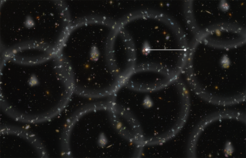One-Percent Measure of the Universe Constrains Dark Energy
The new distance measurements were presented at the meeting of the American Astronomical Society by Harvard University astronomer Daniel Eisenstein, the director of SDSS-III. They are detailed in a series of articles submitted by the BOSS collaboration last month and available online. "Determining distance is a fundamental challenge of observational astronomy," said Eisenstein. "You see something in the sky -- how far away is it?"
Distances to planets in the solar system can be measured very accurately using radar, but for more distant objects astronomers must turn to less direct methods. Only a few hundred stars and a small number of star clusters are close enough to have distances measured with one-percent accuracy. Nearly all of these stars are only a few thousand light years away and still within our own Milky Way galaxy. Reaching out to distances a million times larger, the new BOSS measurements probe far beyond our galaxy to map the Universe with unprecedented accuracy.
"Making a one-percent measurement at a distance of six billion light years is a huge step forward," explained Eisenstein, "and it requires a completely different technique from measurements in the solar system or the Milky Way."

An artist's concept of the new measurement of the size of the Universe.
The gray spheres show the pattern of the "baryon acoustic oscillations" from the early Universe. Galaxies today have a slight tendency to align on the spheres -- the alignment is greatly exaggerated in this illustration. By comparing the size of the spheres (white line) to the predicted value, astronomers can determine to 1% accuracy how far away the galaxies are.
BOSS measures baryon acoustic oscillations (BAO), subtle periodic ripples imprinted in the arrangement of galaxies in the cosmos. These ripples are descendants of pressure waves that moved through the plasma of the early universe, which was so hot and dense that particles of light (photons) were tightly coupled to the protons and neutrons (known collectively as "baryons") that make up the nuclei of atoms. The size of these periodic ripples can be calculated from fundamental physics and used as a ruler that can be measured very precisely.
Ariel Sanchez and Francesco Montesano, junior researchers at the Max Planck Institute for Extraterrestrial Physics, led a companion paper that determined the extent of the BAO standard ruler not only along the direction perpendicular to the line of sight, but also in the direction parallel to it, analysing the anisotropy in the galaxy clustering. “This allows us to measure not only how far these galaxies are away from us, but also how fast they are moving,” explains Ariel Sanchez. “This means we can determine the rate at which the Universe was expanding at the time when the light we observe today left those galaxies six billion years ago.”
The BOSS team presented preliminary BAO measurements from its early galaxy maps a year ago, but the new analysis covers a larger volume of the Universe and thus provides a more accurate measurement, mapping the locations of 1.2 million galaxies. It also includes the first BAO measurements from a sample of more nearby galaxies.
“The distant galaxies allow us to look back to a time, when the Universe was about half its current age, the more nearby galaxies show us a more mature Universe,” says Ariel Sanchez. “When we take both measurements together, we get really powerful constraints on the properties of the dark energy component we think is responsible for the current acceleration of the expansion of the Universe.”
For now, the BOSS measurements appear consistent with a form of dark energy that stays constant through the history of the Universe in contrast to both ordinary and dark matter, which are diluted as the universe expands. This dark energy seems to be an irreducible energy associated with space itself, and is sometimes also interpreted as a "cosmological constant". This theory has now become the standard model for dark energy. “As our data keeps getting better and better, we will subject this standard model to increasingly stringent tests,” says Ariel Sanchez.
About the Sloan Digital Sky Survey
BOSS is the largest of the four projects that together make up the Sloan Digital Sky Survey III (SDSS-III). Funding for SDSS-III has been provided by the Alfred P. Sloan Foundation, the Participating Institutions, the National Science Foundation, and the U.S. Department of Energy Office of Science. The SDSS-III web site is http://www.sdss3.org .
SDSS-III is managed by the Astrophysical Research Consortium for the Participating Institutions of the SDSS-III Collaboration including the University of Arizona, the Brazilian Participation Group, Brookhaven National Laboratory, Carnegie Mellon University, University of Florida, the French Participation Group, the German Participation Group, Harvard University, the Instituto de Astrofisica de Canarias, the Michigan State/Notre Dame/JINA Participation Group, Johns Hopkins University, Lawrence Berkeley National Laboratory, Max Planck Institute for Astrophysics, Max Planck Institute for Extraterrestrial Physics, New Mexico State University, New York University, Ohio State University, Pennsylvania State University, University of Portsmouth, Princeton University, the Spanish Participation Group, University of Tokyo, University of Utah, Vanderbilt University, University of Virginia, University of Washington, and Yale University.












